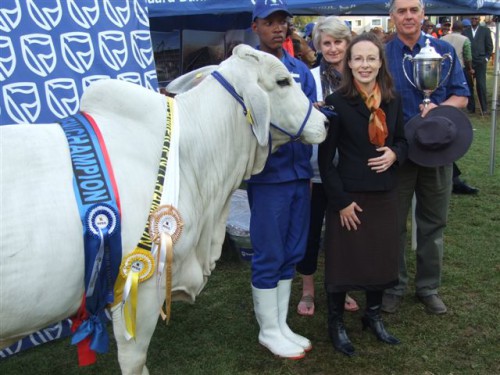3rd October 2011 Windhoek, Namibia
Of bovine beauty and unseasonable weather in Namibia
Being the head of a small diplomatic mission means I get to do an infinite variety of work each week. Never more so than today, when I had to award a prize for a cow. Not just any cow, but the most productive cow in Namibia. For this week is the Windhoek Industrial and Agricultural Show, the premier farming event of the year in Namibia. Farmers from across the country come to the capital with their livestock to compete at a national level. A sort of Yorkshire Show with a desert backdrop.

This year’s show was to be far more like Yorkshire than I expected and rained for most of the day. But that did not hamper the excitement around the prize-giving. I was assured by the event’s organisers that the Queen’s Cup, which I was presenting, was a “very glamorous award”. I was delighted to hand it to farmer Dirk Uys, owner of Sublime, a rather magnificent white Brahman heifer. She had won the accolade by calving for seven years in a row. (This rather put my three children in five years in the shade.)Cows are prestige, glamour and security all rolled into one in Namibia. So much so that, in rural areas, the number of cattle a man has is far more important than cash in the bank. Outside Windhoek, people in agricultural areas tend to look decidedly unimpressed when I concede that, despite being an ambassador, I don’t own a single cow.Agriculture remains the mainstay of the economy in Namibia and beef production accounts for 87% of gross agricultural income. Namibia is well known for producing top quality beef from animals reared on vast pastures. But cattle here represent more than just meat or a more commodity. They are honoured and respected in their own right.

The Namibian reverence for cattle is evident in the traditional dress of the local tribe from the centre of the country, the Herero. The women wear a ‘horned hat’ to denote their close ties to their cattle, which are an integral part of Herero lifestyle. They admonish young girls who walk too quickly in their fantastic traditional Victorian style gowns with chastisements that they must walk more sedately “like a cow”. The Herero also have hundreds of words in their language to describe the markings on their cattle.Throughout the southern African region, cows are exchanged when people get engaged, if they get divorced or if they commit a crime. Besides Namibian law, punishment can be set in terms of numbers of cattle. There are even price lists for various crimes. Crimes committed against other people’s cattle rank as some of the most serious offences in the land.So, it was against this backdrop of local bovine supremacy that I was honoured to present the Queen’s Cup today, despite the early rain. I look forward to brushing up my knowledge of cattle in the coming months and having a more attuned eye to better appreciate the quality on the hoof at next year’s Windhoek Show.
For you can never gain a true understanding of Namibian culture without understanding cows!
